David J. Howe's Blog, page 22
October 28, 2015
Review: Doctor Who Impossible Worlds
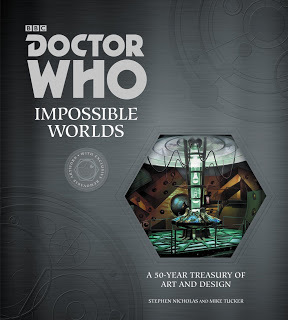
One of the great things about Doctor Who these days is that it is popular enough to sustain the sort of lavish, large format art book which, as a publisher, I can only dream of producing. And this year, the must have book for Christmas is Stephen Nicholas and Mike Tucker's Impossible Worlds.
The book is indeed a lavish art book, but it really needs to be seen to be appreciated fully. What impressed me first was the lovely cut-out hexagon on the cover, through which the front endpaper can be seen, printed with the TARDIS console. This sort of paper engineering costs a fortune, and the heavy stock of the cover is also of great quality ...
But onto the book itself. Stephen Nicholas has been the supervising art director for Doctor Who since the show returned in 2005, and so has access to an incredible array of designs and artwork for the show, each depicting the development of ideas, monsters, sets and spaceships which have then appeared in all their glory. Mike Tucker runs a company called The Model Unit, which specialises in detailed model work for film and television - and some of their work is so good that you would never know or realise that it was a model in the first place! Together they have split the book into sections, each looking at a different aspect of the show: The TARDIS interior, Daleks, Cybermen, Sontarans, other Monsters, Tools and Devices, and alien planets; and in each case, there is a brief look at some of the elements from the classic series (*Disclosure here as I helped with sourcing some of the sketches and designs which are shown*) followed by a more comprehensive and detailed look at how the new series dealt with the elements.

Thus we get gorgeous sketches and artwork of Daleks of every persuasion, showing their internals and externals, ideas for how they open, what variant weaponry they should have, including Davros, Emperors, Supremes, Genesis Ark, Control Rooms ... it's an impressive feat and is repeated with the Cybermen, where some of the early abandoned designs are just nightmarish ...
It's a brilliant book to flip through, to soak up the talent behind the props ... the ideas which didn't make it ... Personally I'm really fond of an artist called Alex Fort, whose designs never seem to make it to screen, but are the most original and artistic perhaps of them all. His Cybermen and Silurians are inspired ... maybe one day we'll see some of his visions on screen.
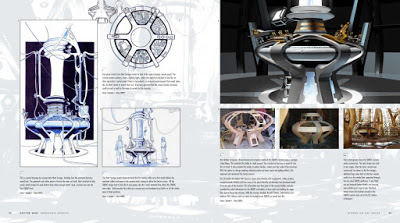
Oh, and if all that wasn't enough, there's a folder in the back containing several full colour art prints of some of the designs - incuding of the Zygon Control Room (or something) from the yet to be transmitted episodes on television ... lovely stuff!
At £35, the book might seem expensive, but it's far more worthwhile than many of the aimed-at-kids picture books which are also being produced at a rate of knotts. Plus, if you shop around you might find it cheaper, or, next year, as with many of the other books released on the show, it might appear in a cheaper edition in W H Smith or The Works, or from The Book People ...
Top marks from me for this, then. A brilliant look at the art and concept design behind the show, highlighting just why Doctor Who is consistently one of the best looking shows on television.
Published on October 28, 2015 02:21
October 27, 2015
Review: Doctor Who: The Underwater Menace (1967)
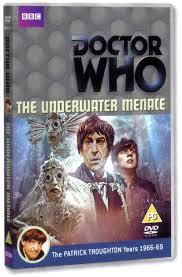 And so it comes to pass that every one of the known-to-exist Doctor Who episodes - with perhaps the sole exception of The Web of Fear Episode 3, which seemed to exist when Phil Morris discovered them, but which had strangely vanished when the episodes were eventually returned - has been released on DVD.
And so it comes to pass that every one of the known-to-exist Doctor Who episodes - with perhaps the sole exception of The Web of Fear Episode 3, which seemed to exist when Phil Morris discovered them, but which had strangely vanished when the episodes were eventually returned - has been released on DVD.I lost count a long time ago as to how many DVDs there have been, but as far as I can tell, the first DVD to be released was The Five Doctors in November 1999 (not counting a could-be-dodgy DVD of the TV Movie which was available from Fox Video in Japan in 1996) and now, in October 2015, 16 years later, we have the final release. Of course, we thought we'd reached the end some time back anyway, but then Phil Morris discovered all six episodes of Enemy of the World and five of the six episodes of The Web of Fear, and those were also released ...

A fishy tale!
But what of The Underwater Menace ... it's not the best loved Doctor Who adventure, and it's easy to see why. Pat Troughton is still settling into the role of the Doctor (this was his third story in the role) and there are occasional flashes of the brilliance that his Doctor will come to embody. Frazer Hines' Jamie is also sidelined, this being because he joined the cast as a late decision, and so he had to somehow be shoe-horned into this story and the next (The Moonbase) before he really started to come into his own ... The main problem though are the guest actors, who are almost uniformly awful. In particular Joseph Furst as Professor Zaroff, who chews the scenery and does his best, but the script doesn't really support him. Likewise the High Priest Lolem comes over as a very camp Christopher Biggins-type character as played by Peter Stephens (interesting that he also played Cyril in The Celestial Toymaker story), and poor Colin Jeavons as Damon has the most crazy eyebrows to contend with. Rounding out the ineffectual is Noel Johnson as King Thous, who doesn't really get to do much. There's also P G Stephens and Paul Anil as a likely couple of chancers, Catherine Howe as an Atlantean girl, as well as fish people ... it's a story with aspirations way beyond what could possibly be done on Doctor Who's budget at the time ... but at least it tried, and it does all make sense ...
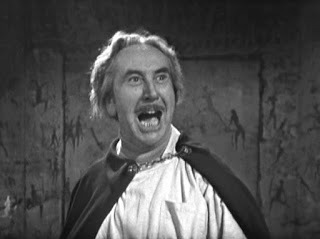
'Nozzink in se Verld ken stop me now!'
The DVD extras include a Making-Of documentary where several people involved in the show recount their memories, and also, inexplicably, present-day writer Robert Shearman is also on hand ... not sure why he's there as he seems to hate the production, but there you go ... There's also the existing two censor cuts from Australia for parts 1 and 4, and those still-missing episodes are represented by a soundtrack accompanied by some of the Tele-snaps taken from the show by John Cura on transmission ... Personally I prefer these to the animations, far better to get the sense of the actual production.
Overall it's lovely to have this disk to round out the collection ... and it's interesting to note that it includes episode 2, recovered in December 2011, which was the last existing episode which had never recieved any DVD release ... so we're complete!
Phil Morris ... it's over to you :)
Published on October 27, 2015 09:56
September 18, 2015
Review: Zardoz (1974)
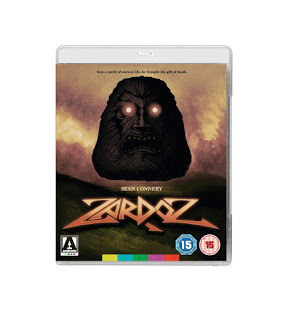
Let's get the elephant in the room out the way immediately: Zardos doesn't make a lot of sense. Director John Boorman has infused with a very hippy-esque sensibility and the science fiction trappings just serve to heighten the feeling that no-one really knew what was going on, but just went with it. Once you get past this, however, the film is lush and beautifully shot, with some great ideas at play: and of course there's Sean Connery in those red trunks!
The film is actually all about Connery, playing a character called Zed, and he's in most scenes as we follow him from his life as a horsebacked Exterminator, killing humans seemingly at random, to his plan to get inside the giant floating head of their god Zardoz, whose effigy arrives through the sky and spews guns and ammo out through it's mouth.
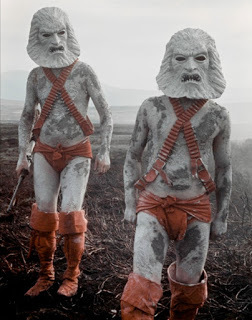
Once inside, Zed kills the head's operator, a man called Arthur Frayn, and arrives in a place of tranquillity and peace, where humans live in comfort and are well fed and watered. But all is not as it seems, as these people are unable to reproduce, and they punish each other by enforced ageing (otherwise they live forever). So poor Zed is made the subject of a hunt, and is used for his seed, while they give him their knowledge in return (and these scenes are rather nicely done, with projected images onto the players moving to show the transfer of the knowledge and skills).

But Zed has a plan and that is to bring his fellow Exterminators in and to breach the barriers which keep them out ... and thus they arrive and kill everyone (however they want to die, so this act is welcomed). Zed then runs off to the crashed giant head with Consuella (Charlotte Rampling) who is pregnant with his child ... and they sit there then for the rest of their lives as the boy grows, leaves them, and they crumble to skeletons and dust ...
It's a bleak ending, and provides no answers or real conclusion. But then the whole film is like that. Overlong (it's 105 minutes apparently, but feels closer to 120!), it plods majestically along, showing us scene after scene, we meet people who have no meaning ... John Alderton as Friend seems out of his depth, Consuella is all for having Zed killed until he shares his seed with her, and then she's happy to run away with him ... there's decadence and boredom for those who are immortal, and death through slavery or by the Executioners for those not inside the protected area ... A very puzzling film indeed.
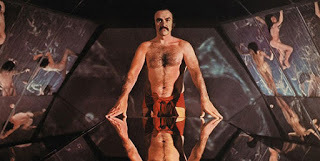
As usual the transfer on this Arrow release is excellent, and the detail really helps to bring Boorman's visions to life. Connery is great as he moves through the film, and the sets and imagery is unique and often startling (if inexplicable).
In terms of extras, there aren't that many this time - maybe Arrow were limited in what could be included.
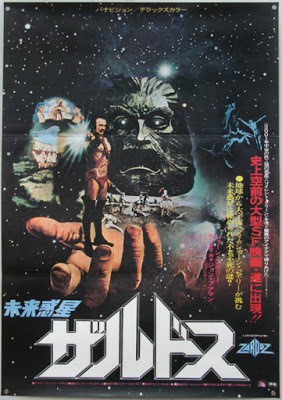
SPECIAL EDITION CONTENTS:
New 4K digital restoration by Twentieth Century Fox, supervised and approved by John Boorman
High Definition (1080p) Blu-ray presentation
Optional English subtitles for the deaf and hard of hearing
Audio commentary with writer-producer-director John Boorman
Brand new interviews with Boorman, actor Sara Kestelman, production designer Anthony Pratt, special effects creator Gerry Johnston, camera operator Peter MacDonald, assistant director Simon Relph, hair stylist Colin Jamison, production manager Seamus Byrne, and assistant editor Alan Jones
Newly filmed appreciation with director Ben Wheately (Kill List, Sightseers, A Field in England)
Theatrical trailer
Radio spots
Reversible sleeve featuring original and newly commissioned artwork by Matthew Griffin
Collector’s booklet containing new writing on the film by Julian Upton and Adrian Smith, plus archive interviews, illustrated by original production stills.
Published on September 18, 2015 03:28
September 15, 2015
Review: Nightmare City (1980)
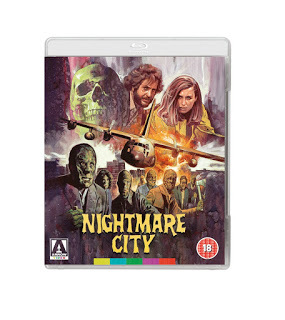
The 1980s gave birth to so many gonzo films, and Nightmare City is among the craziest of them all. Directed by Umberto Lenzi as a sort of pastiche on films like Zombie Flesh Eaters which were themselves drawing on George Romero's Night of the Living Dead, the film is a crazy mish mash of a zombie virus spreading across America while the army and medical staff try to work out what's going on.
It's got all the right ingredients for a great Italian horror film: bad acting, terrible dialogue, zombies that look like they have had their faces covered in honey and then plunged into a box of breakfast cereal ... oh, and it also has some 80s leotard-clad dancing girls, and lots of blood and gore ... what's not to like!
The plot, such as it is, starts when an army plane lands, and disgorges a cargo of flesh eating zombies, who seem impervious to bullets, and who slaughter all the soldiers who come to try and stop them. Filming this are a couple of chaps from a local TV station, who head back there and interrupt some sort of disco dance-off which is being recorded ... before they are all interrupted by another hoard of zombies who kill the girls (one gets one of her breasts sliced off in a moment of true pointless schlock) and anyone else they can find.

And so the film continues in this vein ... hospitals get overrun with zombies, there are zombies at a fairground who chase a couple of our heroes up a helter skelter ride (and the woman falls to her death there), there are zombies in a church, and a zombie priest who attacks our heroes with a large candle ...
In many ways, you can see possible antecedents here to more modern films. It feels a bit like Planet Terror in the schlock horror of the zombies attacking, and there's a flash of Zombieland with the fairground setting ... but really it's nothing like them, just as it's nothing much like the films which inspired it.
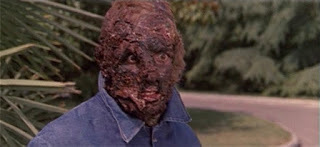
It's basically great fun, but you really have to disengage your brain and go with it ...
As usual on the Arrow disks, there's a host of extras. What's especially interesting is the inclusion of two different prints/transfers of the film: one which is clean and sharp but which has some bad damage to the film; and one which is not so damaged, but which is a lot softer by comparison. There's a short featurette which explains the challenges they had in trying to source the best quality print.
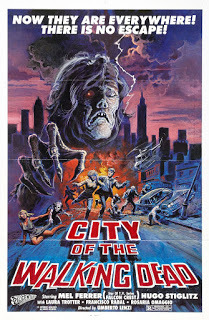
I loved an interview with the director in which he seems to speak non-stop for the duration, barely pausing for breath, and talking about the film, the influences, the effects, the films that came later, and the remake of it which is apparently on the cards at the moment ...
All in all, a great addition to your Blu-Ray library of rubbish Italian horror films which are so poor they are great!
SPECIAL EDITION CONTENTS:
Brand new 2K restoration of the film from the original camera negative
Alternative High Definition transfer from the 35mm reversal dupe negative
High Definition Blu-ray (1080p) and Standard Definition DVD presentations
Original Italian and English soundtracks in mono audio (uncompressed PCM on the Blu-ray)
Newly translated subtitles for the Italian soundtrack
Optional English subtitles for the deaf and hard of hearing for the English soundtrack
Brand new audio commentary by filmmaker, Fangoria editor and Nightmare City fan Chris Alexander
Radiation Sickness – a brand new interview with director Umberto Lenzi
Sheila of the Dead – a brand new interview with star Maria Rosaria Omaggio
Zombies Gone Wild! – director, producer and actor Eli Roth on Nightmare City and the wild cinema of Umberto Lenzi
Nightmare City and The Limits of Restoration – featurette looking at the differences between the two transfers included on this release
Alternate Opening Titles
Original Trailer
Reversible sleeve featuring original and newly commissioned artwork by Graham Humphreys
Collector’s booklet featuring new writing on the film by John Martin, author of Seduction of the Gullible: The Truth Behind the Video Nasty Scandal, illustrated with original archive stills and posters
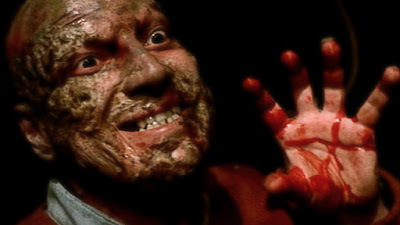
And there is indeed a remake on the cards ... checkout the Web pages all about it here: http://nightmarecity.tv/
And the fundraiser for it is here: https://www.indiegogo.com/projects/tom-savini-umberto-lenzi-present-nightmare-city#/story
Published on September 15, 2015 05:02
September 4, 2015
Review: Videodrome (1983)
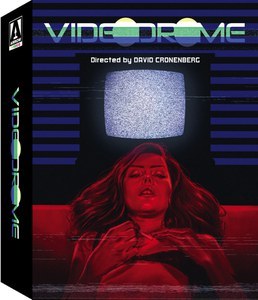 The work of David Cronenberg deserves a place in every film fan's collection, and here Arrow release one of his most intriguing films, Videodrome, along with a package of extras which is guaranteed to set film fans on a high.
The work of David Cronenberg deserves a place in every film fan's collection, and here Arrow release one of his most intriguing films, Videodrome, along with a package of extras which is guaranteed to set film fans on a high.First of all, the film. It's a strange beast, and continues Cronenberg's obsession/interest with transformative body horror. In Rabid it was a blood-drinking barb under the armpit, in The Brood it was babies being born outside of the body as extensions of rage, and of course The Fly is all about the change ... but in Videodrome, it's about how television waves can make you develop a brain tumour and give you hallucinations ... It's poor James Woods who gets the brunt of it. He plays Max Renn who runs a television station and he stumbles across what appears to be a pirate broadcast of a show called Videodrome wherein young women are tortured and killed. He becomes more and more fascinated by the show, and is also intrigued by Nicki Brand (played by Debbie Harry) who he starts a relationship with and discovers has a propensity towards masochism. As the story plays out, so we (and he) discover that Videodrome doesn't really exist, it's been targeted at him by a company called Spectacular Optical run by Barry Convex (Leslie Carlson). He hallucinates his own television coming to life, and a video tape slot opens in his stomach into which tapes can be inserted to 'programme' him ... Convex programmes him to kill all opposition to Videodrome and he murders his own colleagues at the television station. He also tries to kill Bianca O'Blivion (Sonja Smits) (who runs a mission wherein homeless are made to watch television) but she manages to reprogramme him to kill Convex. It all comes to a head on a deserted boat, where Max finds he must sacrifice himself for the sake of 'the new flesh' ...
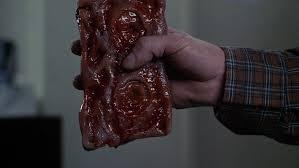
It's a rocky ride, and the effects (courtesy of Rick Baker) are quite astonishing. But the film's narrative is hard to follow as you're never sure what is hallucination and what is real. This was also explored in Cronenberg's later eXistenZ, and one ends up wondering if even the Director knew ... or whether it really matters anyway. James Woods is great in the lead, starting as a television executive looking for the next big thing, and ending up as a controlled puppet of those who want to try and spread their own 'religion' via their hypnotic neural network. Debbie Harry, lead singer with the band Blondie, does well here too, playing a seductive pawn to James. It's not clear whether she is in on it all, or indeed whether she really exists at all ...
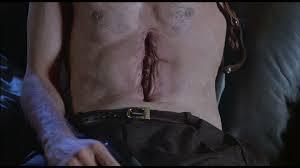
In addition to the main film presentation, the package also contains a set of four of Cronenberg's early films. There's Transfer (1966) and From the Drain (1967) which are short films, and Stereo (1969) and Crimes of the Future (1970) which are longer. I'm not a film historian, but I'm sure these are very interesting to those who like to study and look for themes in a director's work. Personally I found them a little raw - they are mostly silent, with narration and sound effects added, and in all cases are fairly impenetrable to understand. I totally understand why they have been included though, and applaud their release.
Overall, it's another great package from Arrow, with lots of love and care on all aspects of the release of one of Cronenberg's most acclaimed films.
VIDEODROME – BLU-RAY DISC 1 AND DVD DISC 2:
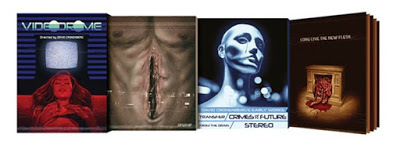
·
Restored
high-definition digital transfer of the unrated version, approved by
director David Cronenberg and cinematographer Mark Irwin
·
Audio commentary by
Tim Lucas, the on-set correspondent for Cinefantastique Magazine and
author of Videodrome: Studies in the Horror Film
·
David Cronenberg and
the Cinema of the Extreme – A documentary programme featuring
interviews with Cronenberg, George A. Romero and Alex Cox on
Cronenberg’s cinema, censorship and the horror genre
·
Forging the New
Flesh – A documentary programme by filmmaker Michael Lennick on
Videodrome’s video and prosthetic make up effects
·
Videoblivion: A brand new interview with cinematographer Mark Irwin
·
A brand new interview with producer Pierre David
·
AKA Jack Martin –
Dennis Etchison, author of novelizations of Videodrome, Halloween,
Halloween II and III and The Fog, discusses Videodrome and his
observations of Cronenberg’s script
·
The complete uncensored Samurai Dreams footage with additional Videodrome broadcasts with optional commentary by Michael Lennick
·
Helmet Test and Betamax – Two featurettes by Michael Lennick on effects featured in the film
·
Camera (2000) Cronenberg’s short film starring Videodrome’s Les Carlson
·
Fear on Film: A round table discussion from 1982 with Cronenberg, John Carpenter, John Landis and Mick Garris
·
Promotional featurette with behind-the-scenes footage and interviews with Cronenberg, James Woods, Deborah Harry and Rick Baker
·
Original theatrical trailer
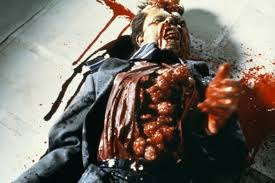
DAVID CRONENBERG’S EARLY WORKS: BLU-RAY DISC 3 AND DVD DISC 4 [LIMITED EDITION EXCLUSIVE]:
·
High Definition Blu-ray (1080p) and Standard Definition DVD presentation of four Cronenberg films
·
Transfer (1966)
& From the Drain (1967), Cronenberg’s previously unavailable short
films newly restored by the Toronto International Film Festival [7 &
12 mins]
·
Stereo (1969) &
Crimes of the Future (1970): Cronenberg’s early amateur feature films,
shot in and around his university campus, prefigure his later work’s
concerns with strange institutions (much
like Videodrome’s Spectacular Optical) as well as male/female
separation (Dead Ringers) and ESP (Scanners). Newly restored from
original lab elements [65 & 70 mins]
·
Transfer the Future – Author and critic Kim Newman discusses Cronenberg’s early works
COLLECTOR’S BOOKLET [LIMITED EDITION EXCLUSIVE]
·
An illustrated
100-page hardback book featuring new writing including Justin Humphreys
on Videodrome in a modern context, Brad Stevens on the alternate
versions, Caelum Vatnsdal on Cronenberg’s early
works, extracts from Cronenberg on Cronenberg featuring Cronenberg’s
reminiscences of getting started in filmmaking and shooting all the
films in this collection, plus more, illustrated with original archive
stills
Published on September 04, 2015 03:15
September 3, 2015
Review: The Time Lord Letters
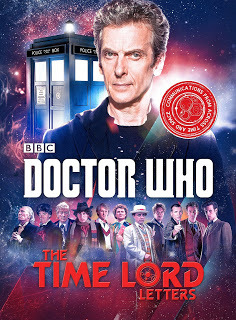
Hot off the presses from the BBC, is (one of) the 2015 hardback(s) tying into Doctor Who. This time, author Justin Richards has thought laterally, and has compiled together over one hundred 'letters' which the Doctor has apparently written, or which have been written about him, over the course of his many incarnations and adventures. And it's a fascinating selection.
Some are fairly 'obvious' in their existence - letters from the first Doctor to Coal Hill School asking them to take on Susan, and an application form for the same ... plus one from the twelfth Doctor applying for the post of caretaker ... but others are a little more esoteric in nature. For example, one from the ninth Doctor to the parents of Adam Mitchell, or letters from and to the eleventh Doctor based around the events of 'Amy's Choice' ...
But possibly my favourite one, which stretches reality in every which way, is from the twelfth Doctor to Agatha Christie, apparently written while he was on the space-going Orient Express. Quite when during that adventure he had time to sit down and write is a little perplexing, but here is a letter.
From a design perspective, the book is a delight, with the letters on created notepapers with little logos and designs for all manner of places and corporations, from the aforementioned Orient Express to ESGO (the gas drilling company from 'Fury from the Deep'), International Electromatics (from 'The Invasion'), Brook House Theatre (from 'Planet of the Spiders'), The Palace Theatre (from 'The Talons of Weng-Chiang') and of course UNIT. I love this level of detail, and the overall impact that the book has is excellent because of it. I also like the various paper and parchment effects, the coffee cup rings, sticky tape marks, stained corners and edges to the photographs ... an awful lot of effort has gone into making this book look and feel like a true scrapbook of the Doctor's letters and correspondence over the years.
Some of it lifts directly from the show: there's sequences from 'The War Games' and 'The Mind Robber' for example, and other words and phrases echo dialogue from the show (as in the second Doctor's letter to Victoria).
Overall, it's a rather nice picture book, beautifully designed, and interesting to flick through. However like most of the books being produced for the show these days, it's also a little esoteric, falling between the stalls of a factual book (it's not that at all - the majority of these letters don't exist in the context of the show itself) and a fiction book (it is closer to this) and an art book (it's certainly packed full of images). But well done to Justin and the designers for coming up with a new take on the show, and managing to pull it together!
The Time Lord Letters is published by BBC Books. £20 rrp. ISBN: 978-1-84990-963-1
Published on September 03, 2015 01:51
September 1, 2015
Classic Monsters of the Movies
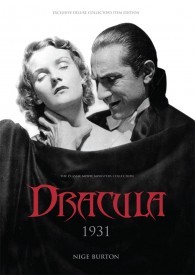
It's not often there's a new horror magazine to go all gooey over ... but Nige Burton has just released the first issue of a new mag called Classic Monsters of the Movies and it's lovely!
I met Nige at a convention in Rotherham called HorrorCon earlier this year, and he had a stand promoting the magazine, and selling copies of two other magazine-format publications, all dealing with similar subjects: classic Horror Movies ... I snapped the two he had available there up!
First off is Dracula 1931 and as you might predict, it's looking at that classic Universal horror film starring Bela Lugosi. While this is a magazine, the production quality is simply superb! Printed on quality paper stock, with a nice sturdy cover, and spot UV varnish, it is just superb. Inside is a comprehensive history and overview of the film, punctuated with facts and figures and biographies of the main players. It's superbly illustrated in black and white for the most part (though the printing is actually full colour throughout) and even takes in Castle 8mm films, the Aurora model kit and the stage play ... there are stills from the film, of the cast and crew, and of course posters galore. It's a magnificent publication! And what's good is that there are further editions planned, each looking at different classic films!
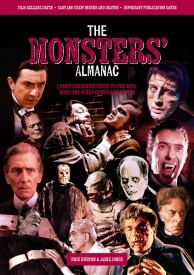
The second publication was The Monsters' Almanac and this has the same super-high quality production standards of the first. This is a neat idea. Taking a year as it's timeline, it chronicles, day by day, the key Classic Monsters happenings as they occurred. So to pick the day I am writing this for example, September 1, I can see that Sandor Eles died on this day in 2002, and that Isle of the Dead was released in 1945 ... just endlessly fascinating to dip into and to find out random facts and information about the golden age of horror film ... As with the Dracula magazine, the photographic content is superb, with lots and lots of excellent images in black and white and colour, many of which seem new to me. It's a brilliant and unusual gift for the horror lover!
Finally to the new magazine, and it's perfect bound, and up to the same quality printing and paper stock as the other magazines. In look, it's probably closest to the classic Famous Monsters of Filmland magazine from the sixties, and I suspect this is deliberate. Inside there are interesting articles on Frankenstein Meets The Wolfman, where Nige Burton argues the validity of this entry into Universal's 'Monster Mash Up' series, there's material on Hammer too, and all their Dracula films go under the spotlight; there's an overview of Zombies in cinema, and a piece looking at the life of Boris Karloff. All are superbly illustrated again, and the whole magazine is beautiful.
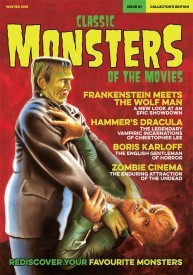 I admire what Nige Burton is trying to do here, and I really hope he gets the support he needs to keep these publications going. I've really not seen anything as quality as them for many years.
I admire what Nige Burton is trying to do here, and I really hope he gets the support he needs to keep these publications going. I've really not seen anything as quality as them for many years.If I've piqued your interest, then head here to find out more and to buy copies, and even to subscribe if you can afford to: http://www.classic-monsters.com/shop/
Published on September 01, 2015 09:28
August 2, 2015
Fringe
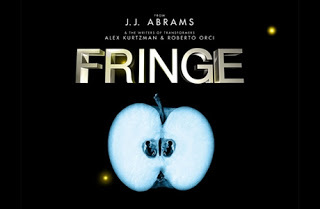
We've just finished watching the whole of the series Fringe and it was an interesting experience. We'd heard a lot about the show from friends, mostly raving about it and saying how amazing it was ... and so we thought we'd see for ourselves.
The series follows the exploits of a small group of people who comprise the FBI's Fringe division - investigating strange events which normal methods cannot explain. In this way it's a little like The X-Files in it's set up, but it takes a completely different direction to that show.
Fringe is headed by Agent Phillip Broyles (Lance Reddick), a no-nonsense officer who acts very much as the voice of reason. He is often seen striding with the others to the scene of the event, explaining everything they need to know. In this respect, he's a little like the caricature which Sergeant Asap portrays in the Touch of Cloth comedy crime series. Then there's Olivia Dunham (Anna Torv). Blonde, beautiful, but haunted by her past (and so she should be, as we discover). She's the perfect, logical, FBI agent looking into these strange happenings. Helping her, and in many ways the mastermind behind Fringe, is Walter Bishop (John Noble). Old, bumbling, forgetful, and with a penchant for red liquorish sticks, Walter knows all the science and the tech and pulls random things from his fragmented memory which helps them to understand what is happening. Walter's assistant is Astrid Farnsworth (Jassica Nicole), a sassy girl, who passes him his test tubes and generally dotes on him. Completing the Fringe 'family' is Peter Bishop (Joshua Jackson), Walter's son, a fairly serious young man, who helps out with the investigations.
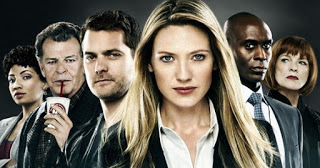
The Fringe team. L to R: Astrid, Walter, Peter, Olivia,
Broyles, Nina
So as the series starts, and with Seasons One and Two, each episode, the Fringe division investigate some strange happening: all the passengers on a plane have been infected with some flesh-dissolving toxin; a baby born fully developed and then aged to death in a matter of minutes; a man able to channel electrical energy; genetically engineered parasites; all are fair game for the Fringe team. All this strange activity seems centred around a lake, and there is a 'pattern' to what is taking place. This also seems to lead back to a massive conglomerate company called Massive Dynamic, and the CEO there is Nina Sharp (Blair Brown).
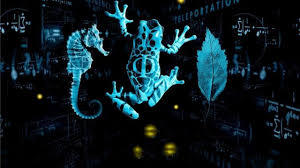 These investigations also often seem to point back to Walter's past, and the things he can't remember - he spent a long time in an institution as he was deemed insane, but then Peter rescued him. And this starts to form the backstory. It seems that Walter was working with another man, William Bell (Leonard Nimoy), and that Billy might still be out there ...
These investigations also often seem to point back to Walter's past, and the things he can't remember - he spent a long time in an institution as he was deemed insane, but then Peter rescued him. And this starts to form the backstory. It seems that Walter was working with another man, William Bell (Leonard Nimoy), and that Billy might still be out there ...This basic idea forms the backbone of most of the seasons. But at the end of the first season, we learn that there is more to all this than meets the eye. There is an alternate and parallel dimension, with equivalents of the Fringe team living there ... in fact it's an almost duplicate of our dimension (but they have airships and a gold Statue of Liberty!). But sometimes the dimensions can touch, and bleed through, and this accounts for several of the Fringe events. But there's more than this ... it is revealed that Peter is actually from the parallel dimension, and that Walter, having lost his own son, arranged to travel between dimensions to steal Peter away.
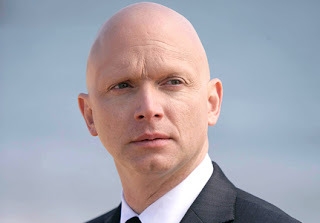
September
And so the scene is set for conflict ... But then we have the Observers. A strange, bald man seen and pictured at many of the Fringe events (apparently he appears somewhere in every episode of the series in which they are investigating an event), and indeed at many significant events throughout Earth's history. He never seems to change, never ages, but is always there. As we discover, the Observers have been watching us through time, making sure that significant events happen when they should, and that the balance of time is maintained. But this was until Peter is rescued from drowning in a lake by one of the Observers - a creature called September (Michael Cerveris) - and in doing so, he changes the course of history.
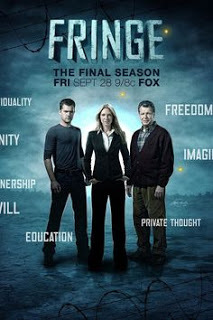
Thus Season Three follows the two parallel universes as they each try to understand what is happening and why. There are parallel Olivias and Walters and Astrids and Broyles', and the two sides investigate similar Fringe happenings ... and of course they can cross over, one to the other as well. There's an element here too of distrust, that each side thinks the other is behind everything. We found that Series Three dragged terribly for the first half, not seeming to know what it was doing or where it was going, then it settles down to being more shenanigans from William Bell in trying to disrupt the dimensions. Added to which Faux-livia (the Olivia from the alternate dimension) swaps places with our Olivia, and has an affair with Peter while spying for her side ...
Series Four starts when the Observers decide that to get time back on track, they have to remove Peter from existence, so they do this, but Peter is too strong, and keeps bleeding through. Thus Season Four is a confused mess ... the Fringe Team don't remember Peter at all, and as time has been reset, some of the Fringe events and characters which we had previously seen and dealt with reoccur ... Peter comes back properly and Olivia regains her memory.
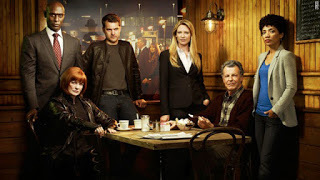
L to R: Broyles, Nina, Peter, Olivia, Walter, Astrid
One of the episodes is set in the Eighties, and has a suitably retro title sequence ... and another is set in the Future, where the Observers have taken over and are running Earth like some military state. And indeed, this is then what is used for the basis of Season Five. The Fringe team were all trapped in Amber (a gaseous substance which hardens instantly to an amber crystal. This had been used in the parallel universe to block off areas where the universes were bleeding together to keep both universes safe) for twenty one years, and now are released by Peter and Olivia's daughter Etta (Georgina Haig) to help in the resistance against the Observers.
But there are issues with all of this. The Observers could time travel and appear at any time, so why do they have a base in a fixed time, and why do they want to take over anyway? (It says on Wikipedia: Numerous Observers from the 27th century, having made the Earth uninhabitable in their own time, travelled through time to take over the Earth from humanity, instituting a Purge to kill off a large fraction.) Battles with them would be pointless as they could just step back ten minutes and disable any plans that humanity tries against them ... but all this seems to be forgotten. Also, Peter gets an Observer chip and puts it in his neck ... not sure why, but the implication is that he is becoming like them - he can move fast, and loses his emotions and hair ... but part way through Season Five this is forgotten about and never mentioned again ...
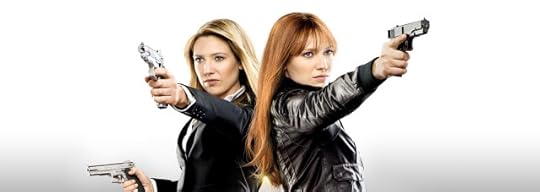
The two Olivias, both played by Anna Torv
Unfortunately this inconsistency with the back story hampers the ongoing series. There are some great characters and ideas here, but if people and things are going to change their operating models from one episode to the next, there's something wrong. Season Five also starts off with Walter, 21 years previously, recording on video tapes all the steps to defeat the Observers, and then sealing them all in their lab with Amber so they can't be seen. So the team have to re-access their lab (which is in the middle of Observer Central, so very unlikely), and get the tapes out one by one with a laser ... but then they are obscure and obtuse ... so the team manage to do about three missions to get the elements they need, but then it's all forgotten again, and for some reason September is now a normal human living in hiding (again from Wikipedia: now more human due to his 'biological reversion' by other Observers for aiding Fringe), and he comes and builds the machine that they have been trying to create ... this leads to the endgame (there are only 13 episodes in Season Five) where they have to somehow change history to stop the Observers taking over. But as noted, these creatures can time travel themselves, so I can't see how this could possibly work ...
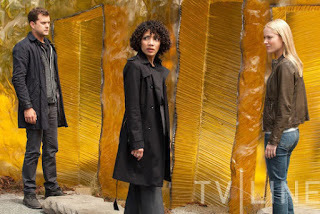
Peter, Astrid and Etta beside the Amber which held
the Fringe team.
There's some great conceits all the way through. The title sequence changes depending on which reality we're following - Blue for ours, Red for the Alternate Universe, Orange for both, and Black for the Observer-controlled future. The characters are all brilliant, with Anna Torv's Olivia Dunham, John Noble's Walter Bishop being the stand outs. Especially when they get to play their alternate universe counterparts, who have different body language and approaches. It's all very well done indeed.
Overall, I'm very glad we spent the time to visit with the Fringe team. The show is original and fast paced as you might expect from J J Abrams, and the acting and scripting is usually first rate. There are some brilliant episodes, and even a partially animated one! The show manages to stay bright and relevant and compelling pretty much all the way through, but as mentioned, it does have its issues, and for Season Three especially, you need a little perseverance to get through the first half! The series is very complex, and it has taken me some time to pen this little piece, trying to ensure I get the facts right, and realising that I missed several elements of the show as we went through!
It feels that after the first three Seasons they started to run out of ideas (but there are so many ideas and concepts in the show - far more than I have mentioned in this quick review - check out the Wikipedia pages for a more detailed summary of the seasons and their themes and backstories) that this must be wrong ... there is a sense of sameness creeps in though, not helped by the characters being taken back and 'reset' at various points both in our and the alternate universe), but kept getting renewed and so had to come up with reasons and plots to keep it all running. The individual episodes of investigation mostly stop around Season Three, and the show becomes all about the characters and backstory, as common with nearly all genre shows, and as I have said in the past, it suffers for it.
If you'd like to see all the different title sequences they used, well here they are ...
Published on August 02, 2015 04:54
July 2, 2015
Review: Contamination (1980)

Contamination is well known as a 'rip off' of the film Alien, whereas in fact, the two films actually have very little to do with each other. Even the director admits that he was 'inspired' by the Ridley Scott film ... but it's hard to see where that inspiration touched on Contamination. The alien-flick Inseminoid is far more of a pastiche on Alien.
Contamination starts with a ship arriving in New York, but the crew are all dead, torn apart by something. Then a cargo of strange egg-like objects are found, and one of them, being heated by some pipes, explodes, spreading an acid-like substance all over those investigating the ship, and they promptly explode from within. Quite why all this happens is glossed over - the eggs are not eggs as they don't contain any life form, instead harbouring some sort of alien fungus/infection which makes people explode.
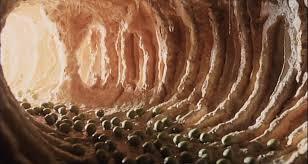
Cue Ian McCulloch as a drink-soaked ex-astronaut Hubbard who apparently encountered similar eggs on a trip to Mars ... they track the ship back to South America, where McCulloch, and a scientist lady, Stella Holmes (Louise Marleau) head to try and find the source. They find a plantation full of eggs, and a warehouse full of them too. Holmes is nearly killed when an egg is placed in her bathroom and the door locked (who has a lock on the OUTSIDE of the bathroom door? And she does everything but maybe cover the egg up to stop it exploding all over her).
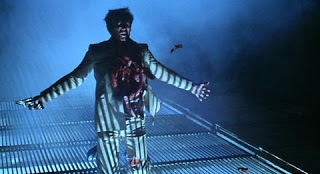
In the end, an alien creature is located which is the source of the eggs, but it sits there in all its rubbery goodness and does very little, mesmerising others to come to it so it can eat them. It is set on fire and the world is saved.
Unfortunately it's never clear just what threat the eggs pose, or why they are being sent all over the world. They don't hatch alien monsters, just explode, making those humans who are in the way explode as well. All seems a little pointless.
As always with these Italian films, the dubbing is poor to unbelievable, and the acting (aside from McCulloch who is rather good) is pretty sub-par as well. I love Marina Mase as a NY Cop boogieing with dancing natives when they arrive in South America.
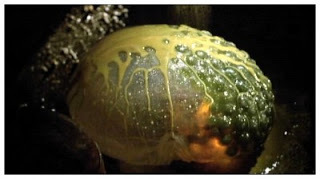
Fans of this particular Italian genre of rip-off films will love this, and there are a host of great extras to enjoy as well. Interviews with the director Luigo Cozzi, with Maurizio Guarini from Goblin (who provide a fairly poor soundtrack to the film) and features on this particular area of 'Mockbuster' Italian film.
SPECIAL EDITION CONTENTS:
High Definition Blu-ray (1080p) and Standard Definition DVD presentation
Optional English SDH subtitles for the deaf and hard of hearing
Feature Commentary by filmmaker, Fangoria editor and Contamination super-fan Chris Alexander
Luigi Cozzi on the Creation of Contamination – an archive documentary hosted by the director and including behind-the-scenes footage
2014 Q&A with Cozzi and star Ian McCulloch
Sound of the Cyclops: Goblin’s Maurizio Guarini on the music of Contamination – the Goblin keyboardist discusses Contamination’s dark, progressive rock score and a lifetime of making music for Italian terror
Imitation Is The Sincerest Form of Flattery – A critical analysis of the Italian “Mockbusters” trend of filmmaking which sought to capitalize on the success of Hollywood blockbusters
Theatrical Trailer
Reversible sleeve featuring original and newly commissioned artwork by Gary Pullin
Collector’s booklet featuring new writing on the film by Chris Alexander, illustrated with original archive stills and posters
Published on July 02, 2015 08:27
June 22, 2015
Review - The Hound of the Baskervilles (1959)
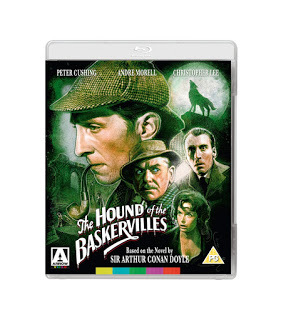
Hammer Films were the staple for so many nightmares ... and yet the Horror films they made were supplemented with other films ranging from comedies (On the Buses anyone?) to psychological thrillers and dramas. They also dabbled in Sherlock Holmes, and their presentation of the classic tale The Hound of the Baskervilles has to be one of the best and most memorable.
Now Arrow have pulled the films from the vault, cleaned them up, and given them a smart new release on Blu-Ray, along with their usual panoply of extras.
The first thing to say, though, is that the film seems a little dark and murky. Certainly not as clean and sharp as I might have expected. I hope this isn't a fault or something.
But overall the film is more horror than some of Hammer's horror fare. The opening sequences make great use of Hammer's staple of historically-based tales, with a group of louche gentlemen, led by Sir Hugo Baskerville, tormenting a peasant - in this case, they throw him through a window into a moat/lake, half drown him, and then drag him back and kill him by roasting him on an open fire! Then a girl - of course it's all about a girl - escapes into the night and onto the moors, chased by the crazed Sir Hugo, who is then set upon and savaged by some monster ... a perfect opening ...
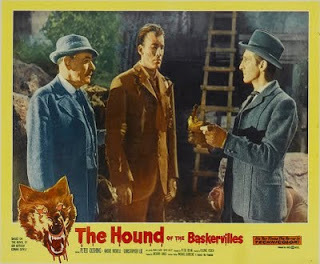
But it's in the casting of Peter Cushing as Holmes, against Andre Morell as Watson, and Christopher Lee as Sir Henry Baskerville in the 'present day' where the film succeeds. All three are perfect in their roles, and so, so watchable as they play out the tried and trusted plot. The Whodunnit is well established ... is it the faithful Baskerville retainers, the Barrymores (another piece of great casting with John LeMesurier as the Butler), or perhaps the Staplefords (and here is the film's only mis-step in casting Marla Landi as Cecile Stapleford, as she has a very obvious European accent. Why would Stapleford's daughter have such an accent? There's no reason and no explanation.). What has the escaped prisoner on the moors have to do with it? And why is Holmes absent for the first half?
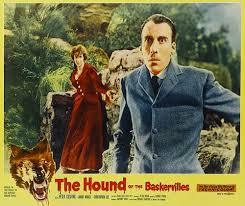
Of course all the answers come, and it's a genuine pleasure to see the cast perform the material. It's a great film, which hasn't really dated at all, and which has all the hallmarks of Hammer. Possibly the greatest Horror film they never made!
As mentioned, there are a host of extras on the disk:
High Definition Blu-ray (1080p) feature presentation
Original uncompressed Mono 1.0 Audio
Isolated Music and Effects Soundtrack
Optional English subtitles for the deaf and hard of hearing
New audio commentary with Hammer experts Marcus Hearn and Jonathan Rigby
Release the Hound! – a brand new documentary looking at the genesis and making of the Hammer classic, featuring interviews with hound mask creator Margaret Robinson, film historian Kim Newman, actor/documentarian and co-creator of BBC’s Sherlock Mark Gatiss, and others
André Morell: Best of British – a featurette looking at the late great actor André Morell and his work with Hammer
The Many Faces of Sherlock Holmes – a 1986 documentary looking at the many incarnations of Conan Doyle’s celebrated character, narrated and presented by Christopher Lee
Actor’s Notebook: Christopher Lee – an archive interview in which the actor looks back on his role as Sir Henry Baskerville
The Hounds of the Baskervilles excerpts read by Christopher Lee
Original Theatrical Trailer
Extensive Image Gallery
Reversible sleeve featuring original and newly commissioned artwork by Paul Shipper
Collector’s booklet featuring new writing on the film by former Hammer archivist Robert J.E. Simpson, illustrated with original archive stills and posters

Published on June 22, 2015 03:40



